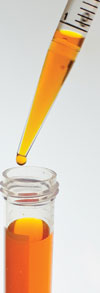

This article is intended to provide introductory information on the principles and techniques for reliable installation and accurate performance of a complete liquid dosing system.
Metering pumps find many applications in industrial liquid dosing systems. These include the dosing of chemicals for boiler tube de-scaling, all forms of water treatment such as demineralisation and effluent control and many more. Metering pumps differ from other forms of pumps and are designed to operate with a high level of repetitive accuracy and be able to dose a wide variety of chemicals such as acids, bases, corrosive or viscous liquids and slurries. They are positive displacement with a linear delivery curve and the ability to vary capacity manually or automatically.
Drives can be fixed or variable speed and some pumps come with stroke adjustment either manual or actuator operated, for applications that dictate fixed speed and controllable capacity adjustment by the stroke mechanism. Generally, sera pumps are robust, oil filled and gearbox driven, giving exceptional reliability and economic operational performance. Pump capacities may be increased while retaining required system pressure by adding additional pump heads.
Principle of operation
Metering pumps transfer media in two stages, the intake stroke and the output stroke. During the intake stroke liquid is pulled into the pump cavity and past the inlet valve. During the output stroke the inlet closes and the output valve opens and the fluid is forced out. Due to the reciprocating action and two stage operation, delivery is pulsating and additional equipment must be installed in order to obtain a constant smooth flow. Pulsation dampers fitted to the suction and delivery sides achieve this while also reducing pipe vibration and overall system component stress.
The dosing system designed
Taking a general application where an additive is to be dosed from its bulk container into a process continuously and without pulsation. Usually, no automatic control is required as manual stroke adjustment is sufficient to attain the accuracy of dosage required.
Accurate calibration of the dosage rate is however a pre-requisite and pump protection is required to protect against pump overload should the main process plant shut down unexpectedly and the dosing pump continue to run. (Incidentally diaphragm pumps can run dry but will self-destruct if they pump against a closed head, so fit a pressure relief valve.)
First, the pump must be sized for approximately 70% normal operating capacity and a pressure relief valve selected. Then, the supply tank is checked to ensure it is covered and not subject to dirt ingress and that the outlet to the dosing pump is above the floor of the tank to avoid any sludge or sediment being drawn into the pump suction. An isolation valve is fitted to the tank, which should also have a drain valve. A dirt trap is fitted in the suction line and a calibration cylinder fitted close to the pump inlet.
A pulsation damper is installed in the dosing pump delivery line and this will smooth the pump delivery to ensure a continuous accurate flow. At the point of dosage into the main process a dosing valve is fitted which is a non-return to prevent back flow from the main line.
Typical application constraints may include low flow rate, high accuracy, high system pressure, difficult media, corrosive, hazardous, high temperature, high viscosity or handling of suspensions and solutions. Dosing may also need to be done under the control of a computer, PLC or DCS.
A wider appreciation of the capabilities of metering pumps can enhance process design and eliminate many unnecessary items, placing the pump rightfully as a precision piece of modern process control equipment. Readers wanting more information on the design and installation considerations pertinent to accurate liquid dosing applications can visit: http://instrumentation.co.za/+C14116A
For more information contact Wally Feldon, sera DoseTech SA, +27 (0)11 397 5120, [email protected], www.sera-web.co.za

© Technews Publishing (Pty) Ltd | All Rights Reserved